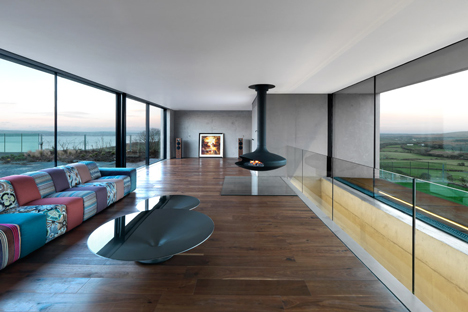|
Stormy Castle, Gower
The chaired masters would have missed you. Returning, weather-watching, to the old halls On the hill-sides, they would have glanced askew At the smooth nape of your slope, gable-less, Passed you by like some half-remembered rhyme. For me your bracken-gate parted, its flat truss Of rusted fern opening on a lane of hazel wards Bent low, a concrete quadrant and a hidden door In the hill. Into gleam-lined halls, girder-made Sidhe of polished steel and wide platforms walled With sealed windows, where the light washed in From the eastern vistas and was never still. Oystercatchers tilled the shoreline below And waders sifted cordgrass in the shifting silt, Poets in passing on the far side of the flow. |
In August 2014, the National Eisteddfod was held in Carmarthenhsire on the Festival Fields of the Millenium Coastal Path in Llanelli. I was the first appointed resident poet for the Gold Medal for Architecture, and had previously visited the six new builds on the short-list. The Eisteddfod fields that year afforded a view over the river Llwchwr to the Gower Peninsula and a prominent hill on the promontory. This is Llanmadoc Hill, and in July I had visited an incredible house built into the side of the slope. It was almost invisible from the Eisteddfod site, but I knew it was there, hidden from view like some mythic cave.
Its concealed nature was not the only otherwordly aspect to Stormy Castle. I parked my car in Pen-clawdd on a wonderful summer morning, and met up with James Stroud, one of the architects responsible for designing the house for Loyn and Co. The owner was expecting us in his home in the hill and, as we drove on, James outlined the background for the project. The owner - a London banker with family ties to the area - wanted the building to blend in with the natural surroundings. The architects decided to dig into the hill on the site of a ruined farmhouse that had once stood quite prominently on the slope, which would now naturally follow the contours of the new build inside. James pointed towards the house in the distance, and I peered for a while before catching sight of Stormy Castle's wide walls and windows on the incline.
It made me think of the medieval courts of the Welsh nobility, which the poets would praise lavishly as prominent icons in the landscape. Moeliwrch, the home of Hywel ab Ieuan Fychan near Llansilin, was haul y fron 'the sun on the knoll' according to Guto'r Glyn. The brighter the better in those days. And the poets would have free passage, of course, through the open door at all times. James pressed the intercom by the main entrance of Stormy Castle, and a great big rusted gate rolled open slowly, leading us up a drive to an open court. The owner welcomed us warmly and gave us an engaging tour of his home. We walked down crisp concrete corridors and through hidden doors, but what struck me most were the sublime views to the distant east through yawning windows. The three of us then walked to the top of the hill behind the house, where we could take in the whole headland doused in haze, the land and the sea stretching away from us in every direction. It being July, I could see the pink canvas of the Eisteddfod pavilion on the other side of the estuary. It seemed far, far away. It came as no surprise to many that the Gold Medal was in due course awarded to Loyn and Co. Congratulations! This poem (written at the request of the architects) is an English counterpart to the Welsh poem commissioned by the Eisteddfod. I also visited as part of the commission some five other buildings of note that had been short-listed for the Gold Medal for Architecture, responding in verse to each in turn. All these poems are available in Welsh: ● Old Farm Mews, Dinas Powys ● Ffwrnes, Llanelli ● New Barn, Felindre ● Melin Talgarth (English version also available) ● Capel Galilea, Llanilltud Fawr Clicia fan hyn i weld fersiwn Cymraeg o'r gerdd hon.
|
